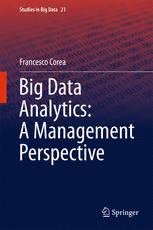Table Of ContentStudies in Big Data 21
Francesco Corea
Big Data
Analytics:
A Management
Perspective
Studies in Big Data
Volume 21
Series editor
Janusz Kacprzyk, Polish Academy of Sciences, Warsaw, Poland
e-mail: [email protected]
About this Series
The series “Studies in Big Data” (SBD) publishes new developments and advances
in the various areas of Big Data- quickly and with a high quality. The intent is to
cover the theory, research, development, and applications of Big Data, as embedded
in the fields of engineering, computer science, physics, economics and life sciences.
The books of the series refer to the analysis and understanding of large, complex,
and/or distributed data sets generated from recent digital sources coming from
sensors or other physical instruments as well as simulations, crowd sourcing, social
networks or other internet transactions, such as emails or video click streams and
other. The series contains monographs, lecture notes and edited volumes in Big
Data spanning the areas of computational intelligence incl. neural networks,
evolutionary computation, soft computing, fuzzy systems, as well as artificial
intelligence, data mining, modern statistics and Operations research, as well
as self-organizing systems. Of particular value to both the contributors and the
readership are the short publication timeframe and the world-wide distribution,
which enable both wide and rapid dissemination of research output.
More information about this series at http://www.springer.com/series/11970
Francesco Corea
Big Data Analytics:
A Management Perspective
1 3
Francesco Corea
Rome
Italy
ISSN 2197-6503 ISSN 2197-6511 (electronic)
Studies in Big Data
ISBN 978-3-319-38991-2 ISBN 978-3-319-38992-9 (eBook)
DOI 10.1007/978-3-319-38992-9
Library of Congress Control Number: 2016940111
© Springer International Publishing Switzerland 2016
This work is subject to copyright. All rights are reserved by the Publisher, whether the whole or part
of the material is concerned, specifically the rights of translation, reprinting, reuse of illustrations,
recitation, broadcasting, reproduction on microfilms or in any other physical way, and transmission or
information storage and retrieval, electronic adaptation, computer software, or by similar or dissimilar
methodology now known or hereafter developed.
The use of general descriptive names, registered names, trademarks, service marks, etc. in this publication
does not imply, even in the absence of a specific statement, that such names are exempt from the relevant
protective laws and regulations and therefore free for general use.
The publisher, the authors and the editors are safe to assume that the advice and information in this book
are believed to be true and accurate at the date of publication. Neither the publisher nor the authors or the
editors give a warranty, express or implied, with respect to the material contained herein or for any errors
or omissions that may have been made.
Printed on acid-free paper
This Springer imprint is published by Springer Nature
The registered company is Springer International Publishing AG Switzerland
To my parents, without whom I would
not be who I am today
To my brother, whom I admire and draw
inspiration from
And to Lucia, who made me a better man,
And whose smile brings light into my days.
Your love and support encouraged
me to chase my dreams,
And any small success I might reach
is as much yours as it is mine.
Acknowledgements
The work is the result of the fruitful manifold conversations with a variety of
different professionals and scientists with manifold backgrounds. So, even if it is
impossible to personally thank everyone, the author is grateful to all the support
and help in creating and designing this book. In particular, the work has been
written while the author was an Anthemis Fellow, and with Anthemis professional
and financial support. Part of the work has been done with many companies within
the Anthemis ecosystem, thanks to the period the author spent directly working
there. The author has also benefited from the advice and helpful comments of Gaia
Fasso, Erica Young, Jacques Ludik, and Charles Radclyffe. However, all the work
and any mistake remain author’s own and the paper represents uniquely his view.
vii
Contents
1 Introduction ................................................ 1
References .................................................. 3
2 What Data Science Means to the Business ....................... 5
References .................................................. 17
3 Key Data Challenges to Strategic Business Decisions .............. 19
3.1 Data Security, Ethic, and Ownership ......................... 19
3.2 The Data Ecosystem ...................................... 22
3.3 Initial Public Offering .................................... 22
3.4 Growth Strategies: Acquisitions, Mergers, and Takeovers ......... 22
3.5 Emerging Markets ....................................... 23
References .................................................. 24
4 A Chimera Called Data Scientist: Why They Don’t Exist
(But They Will in the Future) .................................. 25
References .................................................. 30
5 Future Data Trends .......................................... 31
5.1 The Internet of Things (IoT) ............................... 32
5.2 The Cloud .............................................. 32
5.3 Application Programming Interfaces (APIs) ................... 33
6 Where Are We Going? The Path Toward an Artificial Intelligence ... 35
7 Conclusions ................................................ 37
Appendices .................................................... 39
ix
List of Figures
Figure 2.1 Big data lean deployment approach ....................... 8
Figure 2.2 Internal data management process ........................ 9
Figure 2.3 Big data maturity map .................................. 13
Figure 2.4 Maturity stage transitions ............................... 14
Figure 2.5 Data analytics organizational models ...................... 14
Figure 4.1 Data scientist core skills set ............................. 26
Figure 4.2 Data science value chain ................................ 29
xi
List of Tables
Table 2.1 Data stage of development structure ....................... 11
Table 4.1 Data scientists’ personality assessment and classification ...... 28
Table A.1 Data science maturity test classification .................... 43
Table A.2 Data scientist personality classification .................... 46
xiii

